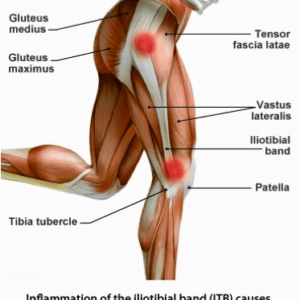Iliotibial Band Syndrome
What causes IT Band Syndrome?

Anyone who has experienced the pain from IT Band Syndrome can tell you that it can be pretty debilitating. Pain to the point of not wanting to bend your knee. Pain that causes a limp even when walking. So, what causes this IT Band pain? Well, there are several factors that play a role in this irritating pain on the outside of the knee.
1. Overuse
It is easy to blame IT Band Syndrome on overuse. This is because probably 99% of the time it is brought on by an increase in training. You sign up for the local half marathon and all of the sudden you need to start a running regimen. Before you know it you are plagued with this lateral knee pain that starts a mile into every run. It is likely that your body’s muscles were not ready for this increase in running, and it is leading to an overly tight Tensor Fascia Latae (TFL) muscle, which is connected to the Iliotibial Band causing pain in the outside of the knee.
2. Hip Stability
The TFL is a muscle located on the outside of your hips right above where your pockets are. If your hands are in your pockets, pull your hands out of your pockets and straight up to the side of your hips and that is about the area of your TFL muscle. This muscle helps to flex (forward) and abduct (outward) your leg. When standing on one leg, this muscle helps to stabilize the leg that is planted on the ground. With every step, either walking or running, this muscle contracts to keep the hip and knee stable and in line with your foot. Other muscles that aid in abduction, or outward motion, of the hip are the Gluteus Maximus, Gluteus Medius, and Gluteus Minimus.
Why does the TFL get tight?
First, when you increase your running or walking, and the Gluteal Group muscles aren’t strong enough and ready to stabilize the hip, the TFL is forced to do more work than usual. This increased load in the TFL puts tension on the IT Band and fascia on the outside of the thigh, which can eventually lead to pain. Second, because the TFL is also a hip flexor, it is in a shortened position the majority of the day when we are in the seated position. After a workout, which creates micro-tears within the muscle, if the muscle is constantly in a shortened position, it will begin to heal in this shortened position. If this is performed over and over again without doing any activities to help reintroduce stretch and elongation of the muscle and fascia, the TFL will progressively get tighter and tighter.
3. Foot and Shoe Issues
The posture and stability of the feet are very important in the motion of the knee and hip when walking and running. All other things being equal, a major problem in your feet or shoes can completely alter the movement in your knees and hips. Over-pronation of the foot, usually caused by a flat foot, is one of the most common problems involving the feet and shoes. A flat foot, or Pes Planus, is a condition where the arch of the foot collapses. This can be either structural or functional. A structural flat foot is described when the actual structure of the foot is flat no matter what position the foot is in. A functional flat foot is described when the normal arch exists in the foot; however, it collapses when in the weight bearing position (ie. standing, walking, running). The functional flat foot is the most common type of flat foot, and is also the most preventable. Postural support of the foot with the correct shoe, and strengthening exercises of the muscles of the lower leg and foot can both help to correct and prevent over-pronation caused by the functional flat foot.
